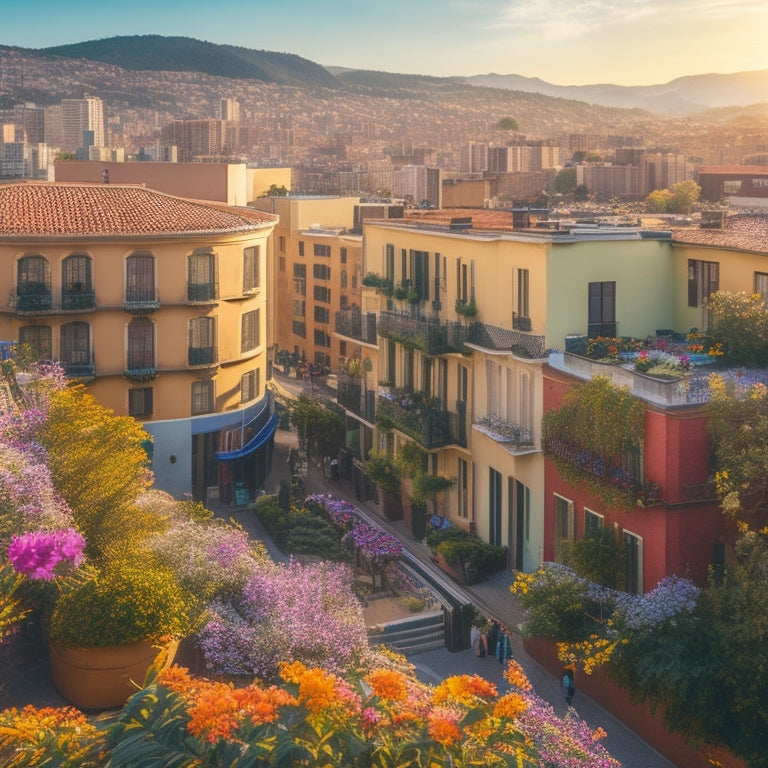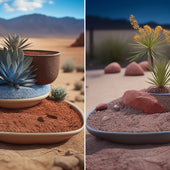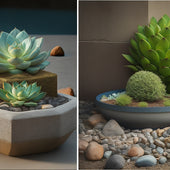
Rooftop Blooms: Elevating Urban Spaces With Flowers
Share
As you envision transforming urban spaces, rooftop gardens emerge as tranquil escapes, mitigating urban stressors and enhancing livability. By selecting drought-resistant flowers, wind-tolerant plants, and shade-tolerant blooms, you can create a thriving oasis. Strategic design elements, like color and texture choices, promote relaxation and entertainment. Beyond aesthetics, rooftop gardens provide ecosystem services, improving air quality, regulating humidity, and supporting local wildlife. As you explore the possibilities of rooftop blooms, you'll discover how to elevate urban spaces, one petal at a time, and reveal the full potential of these elevated retreats, where the boundaries of nature and architecture blur.
Key Takeaways
• Rooftop gardens provide tranquil atmospheres, mitigating urban stressors and enhancing livability through strategically placed green spaces.
• Drought-resistant flowers like succulents and sedums thrive in rooftop conditions, while wind-tolerant plants like ornamental grasses withstand gusty winds.
• Proper soil depth, drainage, and thoughtful design elements promote relaxation, entertainment, and personal style in rooftop spaces.
• Green walls and rooftops can improve air quality, regulate humidity, and enhance air circulation, promoting healthier urban environments.
• Strategic color and texture choices in flower selection can reflect personal style, create visual interest, and influence emotional responses in rooftop blooms.
Urban Oasis in the Sky
As you step onto a rooftop garden, you're immediately enveloped in a tranquil atmosphere, far removed from the hustle and bustle of city life, where lush greenery and vibrant blooms transform the space into an urban oasis in the sky.
This elevated retreat offers a serene escape, where you can unwind and recharge amidst the concrete jungle.
Vertical gardens, cleverly incorporated into the design, maximize space while adding texture and depth to the area. The strategic placement of plants and flowers creates a sense of continuity, blurring the lines between nature and architecture.
As you explore the rooftop retreat, you'll notice the thoughtful consideration given to every detail, from the selection of drought-resistant plants to the clever use of irrigation systems.
Every element works in harmony to create a peaceful ambiance, perfect for relaxation, entertainment, or simply taking in the breathtaking views of the city below.
In this urban oasis, you'll find a sense of belonging, a connection to nature, and a renewed appreciation for the beauty of rooftop blooms.
Floral Arrangements for Rooftops
You'll want to choose floral arrangements that not only complement the rooftop's unique conditions but also thrive in them.
Taking into account factors like wind direction, sunlight intensity, and temperature fluctuations is essential when selecting blooms and greenery for your elevated oasis.
When creating seasonal arrangements, you'll want to take into account the following key factors:
-
Drought-resistant flowers: Choose blooms that can withstand the rooftop's dry conditions, such as succulents or sedums.
-
Wind-tolerant plants: Select greenery that can withstand the rooftop's gusty winds, like ornamental grasses or shrubs with sturdy stems.
-
Shade-tolerant flowers: Opt for blooms that can thrive in partial shade, like impatiens or coleus, for areas receiving indirect sunlight.
- Soil depth and drainage: Make sure your planters have adequate soil depth and drainage to accommodate the rooftop's unique soil conditions.
Colors and Textures Abound
Five core color palettes - monochromatic, complementary, analogous, triadic, and square - can be used to create visually striking rooftop gardens, allowing you to curate a unique aesthetic that reflects your personal style. By understanding color psychology, you can select hues that evoke emotions and create a sense of belonging. For instance, calming blues and greens can promote relaxation, while vibrant yellows and oranges can stimulate energy.
To add depth and visual interest, consider texture layering. Mixing different textures, such as velvety leaves, prickly succulents, and delicate petals, can create a dynamic and engaging atmosphere.
| Color Palette | Emotional Response |
|---|---|
| Monochromatic | Calm, serene |
| Complementary | Energized, playful |
| Analogous | Soothing, harmonious |
| Triadic | Vibrant, dynamic |
Softening Hard Cityscapes
As you reimagine urban landscapes, you're likely thinking about how to soften the harsh edges of city living.
By creating rooftop oases and reviving underutilized green spaces, you can transform concrete jungles into calming retreats.
These intentional designs can help mitigate the stressors of urban life, making your surroundings feel more inviting and livable.
Urban Oasis Creation
By incorporating green roofs and walls into urban landscapes, city dwellers can transform harsh concrete jungles into serene retreats that foster a sense of calm and connection to nature.
As you reimagine your urban space, consider the benefits of vertical gardening, which allows for maximum greenery in minimal space. Container gardening is another option, offering flexibility and ease of maintenance.
When designing your urban oasis, keep the following in mind:
-
Choose the right plants: Select species that thrive in local conditions and provide year-round interest.
-
Consider climate control: Incorporate features like shading, irrigation, and wind protection to guarantee your green space remains healthy.
-
Incorporate hardscaping: Balance greenery with functional features like seating, lighting, and pathways to create a harmonious space.
- Integrate sustainable practices: Incorporate rainwater harvesting, composting, and other eco-friendly elements to minimize your oasis's environmental footprint.
Green Space Revival
How can urban planners and architects breathe life into concrete canyons by strategically inserting green spaces that not only soften the visual landscape but also mitigate the urban heat island effect?
By incorporating sustainable gardening practices, you can create pockets of serenity amidst the hustle and bustle of city life. This can be achieved by designing rooftop gardens, green roofs, and walls that not only provide insulation but also create habitats for local wildlife.
As you envision these green oases, consider community engagement as a crucial component. Involve local residents in the design and maintenance process to foster a sense of ownership and belonging.
This could include community-led gardening initiatives, educational workshops, or volunteer opportunities. By doing so, you'll create a ripple effect of positive change, where urban dwellers can connect with nature and each other.
The result? A revitalized urban landscape that's not only visually stunning but also socially cohesive and environmentally resilient.
Air Quality Improvement Methods
As you explore air quality improvement methods, you'll discover that integrating green walls into urban landscapes can substantially reduce pollutants.
You'll also find that strategically planting trees in urban areas can help absorb harmful particles and produce oxygen.
Green Walls Matter
Incorporating green walls into urban landscapes can greatly bolster air quality by capturing pollutants and particulate matter, allowing you to breathe easier in the midst of bustling cities. As you navigate the concrete jungle, you're constantly surrounded by emissions from vehicles, industrial activities, and construction.
Green walls, a form of vertical gardening, provide a natural barrier against these pollutants, creating a healthier environment for you and your community.
Here are four ways green walls improve air quality:
-
Absorption of pollutants: Green walls absorb pollutants like nitrogen dioxide, ozone, and particulate matter, reducing the amount of toxins in the air.
-
Oxygen production: Plants release oxygen as a byproduct of photosynthesis, increasing the oxygen levels in the surrounding area.
-
Humidity regulation: Green walls help regulate humidity, reducing the formation of ground-level ozone and other air pollutants.
- Air circulation improvement: By creating a natural barrier, green walls improve air circulation, allowing fresh air to enter and stale air to escape.
Urban Tree Planting
You can further enhance air quality in urban spaces by adopting another nature-based solution: urban tree planting, which not only complements green walls but also provides a more extensive canopy to mitigate air pollution.
By strategically selecting tree species that thrive in urban conditions, you can maximize their air-purifying potential. For instance, trees like oak and pine are known to absorb high levels of pollutants like ozone and particulate matter. Effective tree selection also involves considering factors like soil type, sunlight exposure, and maintenance requirements.
Community involvement is essential in urban tree planting initiatives. By engaging local residents in the planning and planting process, you can foster a sense of ownership and responsibility for the trees' upkeep. This can lead to improved tree survival rates and a stronger connection between community members.
Additionally, involving local schools and educational institutions can provide opportunities for environmental education and outreach. By combining tree selection expertise with community involvement, you can create an all-encompassing urban tree planting strategy that not only improves air quality but also builds a stronger, more connected community.
Clean Air Initiatives
Implementing clean air initiatives, such as deploying air purifiers and optimizing ventilation systems, can greatly reduce urban air pollution, empowering citizens to breathe easier.
As you explore ways to elevate your urban space, consider the impact of clean air initiatives on your community's well-being. Air purification systems can be integrated into buildings, parks, and streets, capturing pollutants and toxins, and releasing clean air. This can be especially beneficial in high-traffic areas or near industrial zones.
Here are some effective ways to improve air quality:
-
Green roofs: Planting flowers, grasses, and trees on rooftops can absorb pollutants, reduce urban heat islands, and create habitats for wildlife.
-
Urban algae farms: These innovative systems use algae to absorb CO2 and release oxygen, creating a sustainable air purification method.
-
Air-purifying pavements: Specialized pavement materials can capture pollutants, reducing urban air pollution and improving overall air quality.
- Vertical gardens: These space-saving gardens can be integrated into buildings, providing an additional layer of air purification and aesthetic appeal.
Rooftop Ecosystem Services
As you explore the benefits of rooftop gardens, you'll discover that they offer a multitude of ecosystem services that enhance urban spaces.
Two key benefits of rooftop gardens are their ability to mitigate the urban heat island effect and manage stormwater runoff, making them a valuable ecosystem service in urban spaces. By incorporating vegetation into rooftops, you can reduce the urban heat island effect, which occurs when built-up areas absorb and retain heat, leading to increased temperatures. This not only improves air quality but also reduces the energy needed to cool buildings.
Rooftop gardens also provide biodiversity benefits by creating pollinator habitats. By planting a variety of flowers, you can attract bees, butterflies, and other pollinators, which are essential for urban food systems.
These habitats can also support local wildlife, increasing the overall biodiversity of urban ecosystems. By incorporating rooftop gardens into urban planning, you can create thriving ecosystems that support both humans and wildlife, making cities a more enjoyable and sustainable place to live.
Greening Urban Landscapes
By integrating rooftop gardens into urban design, cities can undergo a transformative process of greening urban landscapes.
As you envision this transformation, imagine the concrete jungle giving way to lush oases, where nature and architecture blend seamlessly. This fusion not only beautifies urban spaces but also fosters sustainable gardening practices, enhances biodiversity, and creates habitats for urban wildlife.
By embracing rooftop gardens, you can:
-
Mitigate the urban heat island effect: Roof gardens provide shade, reduce heat absorption, and create microclimates that benefit both humans and wildlife.
-
Enhance air quality: Vegetation absorbs pollutants, reducing the negative impacts of urbanization on air quality.
-
Conserve water: Rooftop gardens often utilize rainwater harvesting systems, decreasing the strain on municipal water supplies.
- Create habitats for urban wildlife: By incorporating native plant species, rooftop gardens become sanctuaries for local fauna, supporting biodiversity enhancement.
As you join the movement to green urban landscapes, remember that every rooftop garden is a step towards a more sustainable, eco-friendly future.
Frequently Asked Questions
How Do Rooftop Gardens Affect Property Values and Resale Rates?
Like a master chef adding the perfect garnish, you're wondering how rooftop gardens impact property values and resale rates. Research shows they boost property appreciation by up to 15% and drive resale trends, making your investment a sweet deal.
Can Rooftop Gardens Be Designed for Extreme Weather Conditions?
You can design rooftop gardens to thrive in extreme weather conditions by selecting plants adapted to local climate zones and incorporating clever features, such as wind-resistant planters and smart irrigation systems that adjust to weather forecasts.
Are Rooftop Gardens Accessible to People With Disabilities?
As you step into the rooftop oasis, imagine a bridge connecting two worlds - accessibility and nature. You'll find that inclusive gardening practices and accessible design guarantee everyone can bask in the beauty, regardless of ability.
Do Rooftop Gardens Require Special Maintenance and Upkeep Costs?
You'll need to factor in special maintenance and upkeep costs for rooftop gardens, including advanced irrigation systems and seasonal planting schedules, which can add up quickly, but the benefits to your mental and physical health are well worth it.
Can Rooftop Gardens Be Integrated With Solar Panels or Other Green Tech?
"When in Rome, do as the Romans do" - and in this case, you can integrate rooftop gardens with solar panels, embracing sustainable design and harnessing solar energy, creating a harmonious blend of nature and technology.
Related Posts
-

Preventing Soil Settlement in DIY Planters
To prevent soil settlement in your DIY planters, you'll want to focus on selecting a well-balanced soil mix with good...
-

Preventing Soil Settlement in DIY Planters
To prevent soil settlement in your DIY planters, you'll want to focus on selecting a well-balanced soil mix with good...
-

Preventing Soil Settlement in DIY Planters
To prevent soil settlement in your DIY planters, you'll want to focus on selecting a well-balanced soil mix with good...
-

Preventing Soil Settlement in DIY Planters
To prevent soil settlement in your DIY planters, you'll want to focus on selecting a well-balanced soil mix with good...
-

Preventing Soil Settlement in DIY Planters
To prevent soil settlement in your DIY planters, you'll want to focus on selecting a well-balanced soil mix with good...
-

Preventing Soil Settlement in DIY Planters
To prevent soil settlement in your DIY planters, you'll want to focus on selecting a well-balanced soil mix with good...
-

Preventing Soil Settlement in DIY Planters
To prevent soil settlement in your DIY planters, you'll want to focus on selecting a well-balanced soil mix with good...
-

Preventing Soil Settlement in DIY Planters
To prevent soil settlement in your DIY planters, you'll want to focus on selecting a well-balanced soil mix with good...
-

Preventing Soil Settlement in DIY Planters
To prevent soil settlement in your DIY planters, you'll want to focus on selecting a well-balanced soil mix with good...
-

Preventing Soil Settlement in DIY Planters
To prevent soil settlement in your DIY planters, you'll want to focus on selecting a well-balanced soil mix with good...
-

Preventing Soil Settlement in DIY Planters
To prevent soil settlement in your DIY planters, you'll want to focus on selecting a well-balanced soil mix with good...
-

Preventing Soil Settlement in DIY Planters
To prevent soil settlement in your DIY planters, you'll want to focus on selecting a well-balanced soil mix with good...
-

Preventing Soil Settlement in DIY Planters
To prevent soil settlement in your DIY planters, you'll want to focus on selecting a well-balanced soil mix with good...
-

Preventing Soil Settlement in DIY Planters
To prevent soil settlement in your DIY planters, you'll want to focus on selecting a well-balanced soil mix with good...
-

Preventing Soil Settlement in DIY Planters
To prevent soil settlement in your DIY planters, you'll want to focus on selecting a well-balanced soil mix with good...
-

Preventing Soil Settlement in DIY Planters
To prevent soil settlement in your DIY planters, you'll want to focus on selecting a well-balanced soil mix with good...
-

Preventing Soil Settlement in DIY Planters
To prevent soil settlement in your DIY planters, you'll want to focus on selecting a well-balanced soil mix with good...
-

Preventing Soil Settlement in DIY Planters
To prevent soil settlement in your DIY planters, you'll want to focus on selecting a well-balanced soil mix with good...
-

Preventing Soil Settlement in DIY Planters
To prevent soil settlement in your DIY planters, you'll want to focus on selecting a well-balanced soil mix with good...
-

Preventing Soil Settlement in DIY Planters
To prevent soil settlement in your DIY planters, you'll want to focus on selecting a well-balanced soil mix with good...
-

Preventing Soil Settlement in DIY Planters
To prevent soil settlement in your DIY planters, you'll want to focus on selecting a well-balanced soil mix with good...
-

Preventing Soil Settlement in DIY Planters
To prevent soil settlement in your DIY planters, you'll want to focus on selecting a well-balanced soil mix with good...
-

Preventing Soil Settlement in DIY Planters
To prevent soil settlement in your DIY planters, you'll want to focus on selecting a well-balanced soil mix with good...
-

Preventing Soil Settlement in DIY Planters
To prevent soil settlement in your DIY planters, you'll want to focus on selecting a well-balanced soil mix with good...
-

5 Best Trowels for Planting in Concrete Planters
When planting in concrete planters, you need a trowel that can handle the harsh conditions and reduce fatigue on your...
-

5 Best Trowels for Planting in Concrete Planters
When planting in concrete planters, you need a trowel that can handle the harsh conditions and reduce fatigue on your...
-

5 Best Trowels for Planting in Concrete Planters
When planting in concrete planters, you need a trowel that can handle the harsh conditions and reduce fatigue on your...
-

5 Best Trowels for Planting in Concrete Planters
When planting in concrete planters, you need a trowel that can handle the harsh conditions and reduce fatigue on your...
-

5 Best Trowels for Planting in Concrete Planters
When planting in concrete planters, you need a trowel that can handle the harsh conditions and reduce fatigue on your...
-

5 Best Trowels for Planting in Concrete Planters
When planting in concrete planters, you need a trowel that can handle the harsh conditions and reduce fatigue on your...
-

5 Best Trowels for Planting in Concrete Planters
When planting in concrete planters, you need a trowel that can handle the harsh conditions and reduce fatigue on your...
-

5 Best Trowels for Planting in Concrete Planters
When planting in concrete planters, you need a trowel that can handle the harsh conditions and reduce fatigue on your...
-

5 Best Trowels for Planting in Concrete Planters
When planting in concrete planters, you need a trowel that can handle the harsh conditions and reduce fatigue on your...
-

5 Best Trowels for Planting in Concrete Planters
When planting in concrete planters, you need a trowel that can handle the harsh conditions and reduce fatigue on your...
-

5 Best Trowels for Planting in Concrete Planters
When planting in concrete planters, you need a trowel that can handle the harsh conditions and reduce fatigue on your...
-

5 Best Trowels for Planting in Concrete Planters
When planting in concrete planters, you need a trowel that can handle the harsh conditions and reduce fatigue on your...
-

5 Best Trowels for Planting in Concrete Planters
When planting in concrete planters, you need a trowel that can handle the harsh conditions and reduce fatigue on your...
-

5 Best Trowels for Planting in Concrete Planters
When planting in concrete planters, you need a trowel that can handle the harsh conditions and reduce fatigue on your...
-

5 Best Trowels for Planting in Concrete Planters
When planting in concrete planters, you need a trowel that can handle the harsh conditions and reduce fatigue on your...
-

5 Best Trowels for Planting in Concrete Planters
When planting in concrete planters, you need a trowel that can handle the harsh conditions and reduce fatigue on your...
-

5 Best Trowels for Planting in Concrete Planters
When planting in concrete planters, you need a trowel that can handle the harsh conditions and reduce fatigue on your...
-

5 Best Trowels for Planting in Concrete Planters
When planting in concrete planters, you need a trowel that can handle the harsh conditions and reduce fatigue on your...
-

Succulent-Friendly Drainage Solutions for Block Planters
You can create a succulent-friendly drainage system in your cinder block planters by drilling holes in the bottom of ...
-

Succulent-Friendly Drainage Solutions for Block Planters
You can create a succulent-friendly drainage system in your cinder block planters by drilling holes in the bottom of ...
-

Succulent-Friendly Drainage Solutions for Block Planters
You can create a succulent-friendly drainage system in your cinder block planters by drilling holes in the bottom of ...
-

Succulent-Friendly Drainage Solutions for Block Planters
You can create a succulent-friendly drainage system in your cinder block planters by drilling holes in the bottom of ...
-

Succulent-Friendly Drainage Solutions for Block Planters
You can create a succulent-friendly drainage system in your cinder block planters by drilling holes in the bottom of ...
-

Succulent-Friendly Drainage Solutions for Block Planters
You can create a succulent-friendly drainage system in your cinder block planters by drilling holes in the bottom of ...
-

Succulent-Friendly Drainage Solutions for Block Planters
You can create a succulent-friendly drainage system in your cinder block planters by drilling holes in the bottom of ...
-

Succulent-Friendly Drainage Solutions for Block Planters
You can create a succulent-friendly drainage system in your cinder block planters by drilling holes in the bottom of ...
-

Succulent-Friendly Drainage Solutions for Block Planters
You can create a succulent-friendly drainage system in your cinder block planters by drilling holes in the bottom of ...
-

Succulent-Friendly Drainage Solutions for Block Planters
You can create a succulent-friendly drainage system in your cinder block planters by drilling holes in the bottom of ...
-

Succulent-Friendly Drainage Solutions for Block Planters
You can create a succulent-friendly drainage system in your cinder block planters by drilling holes in the bottom of ...
-

Succulent-Friendly Drainage Solutions for Block Planters
You can create a succulent-friendly drainage system in your cinder block planters by drilling holes in the bottom of ...
-

Succulent-Friendly Drainage Solutions for Block Planters
You can create a succulent-friendly drainage system in your cinder block planters by drilling holes in the bottom of ...
-

Succulent-Friendly Drainage Solutions for Block Planters
You can create a succulent-friendly drainage system in your cinder block planters by drilling holes in the bottom of ...
-

Succulent-Friendly Drainage Solutions for Block Planters
You can create a succulent-friendly drainage system in your cinder block planters by drilling holes in the bottom of ...


